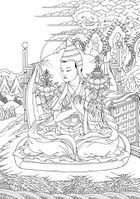Difference between revisions of "Bu ston rin chen grub"
| Line 6: | Line 6: | ||
|HasDnzPage=Yes | |HasDnzPage=Yes | ||
|HasBnwPage=Yes | |HasBnwPage=Yes | ||
| + | |MainNamePhon=Butön Rinchen Drup | ||
| + | |MainNameTib=བུ་སྟོན་རིན་ཆེན་གྲུབ་ | ||
|MainNameWylie=bu ston rin chen grub | |MainNameWylie=bu ston rin chen grub | ||
| − | |||
| − | |||
|AltNamesWylie=bu ston kha che; bu ston thams cad mkhyen pa; | |AltNamesWylie=bu ston kha che; bu ston thams cad mkhyen pa; | ||
|AltNamesOther=Buton Khache; Butön Tamche Khyenpa; Rinchen Drub | |AltNamesOther=Buton Khache; Butön Tamche Khyenpa; Rinchen Drub | ||
| Line 23: | Line 23: | ||
|BdrcLink=https://www.tbrc.org/#!rid=P155 | |BdrcLink=https://www.tbrc.org/#!rid=P155 | ||
|TolLink=http://treasuryoflives.org/biographies/view/Buton-Rinchen-Drub/2845 | |TolLink=http://treasuryoflives.org/biographies/view/Buton-Rinchen-Drub/2845 | ||
| − | |tolExcerpt= | + | |tolExcerpt=Butön Rinchen Drup, a Sakya lama raised in a Nyingma family, was the eleventh abbot of Zhalu Monastery, from 1320 to 1356. Some enumerations list him as the first abbot, as he significantly expanded the institution. He was an important teacher of the Prajñāpāramitā, and a key lineage holder of the Guhyasamāja and Kālacakra tantras as transmitted in the Geluk tradition, and the Kālacakra, Hevajra and Sampuṭa tantras as transmitted in the Sakya tradition. He is generally credited as the creator of the Tibetan Buddhist canon, the Kangyur and Tengyur, and his History of Buddhism is still widely read. In addition to his Sakya training he also studied in the Kadam and Kagyu traditions. |
|images=File:Buton (R. Beer).jpg{{!}}Line Drawing by Robert Beer Courtesy of [http://www.tibetanart.com/ The Robert Beer Online Galleries] | |images=File:Buton (R. Beer).jpg{{!}}Line Drawing by Robert Beer Courtesy of [http://www.tibetanart.com/ The Robert Beer Online Galleries] | ||
|PosBuNayDefProv=Provisional | |PosBuNayDefProv=Provisional | ||
Revision as of 12:19, 26 July 2018
Bu ston rin chen grub on the DRL
| Wylie | bu ston rin chen grub |
|---|---|
| English Phonetics | Butön Rinchen Drup |

- bu ston kha che
- bu ston thams cad mkhyen pa
- Buton Khache
- Butön Tamche Khyenpa
- Rinchen Drub
| Birth: | 1290 |
|---|---|
| Death: | 1364 |
| Place of birth: | khro phu (gtsang) |
Tibetan calendar dates
| Day | |
|---|---|
| Month | |
| Gender | Male |
| Element | Iron |
| Animal | Tiger |
| Rab Jyung | 5 |
- Religious Affiliation
- Sakya; Nyingma; Kagyu; Kadam
- Familial Relations
- Zhalu Monastery
- Students
- sgra tshad pa rin chen rnam rgyal · phyogs las rnam rgyal · bcu gnyis gsar ma grags pa shes rab · gangs dkar bla ma rin chen bzang po · 'jam dbyangs grags pa rgyal mtshan · g.yung ston rdo rje dpal bzang po · g.yag sde paN chen
Other Biographical info:
- BDRC Link
- https://www.tbrc.org/#!rid=P155
- Treasury of Lives Link
- http://treasuryoflives.org/biographies/view/Buton-Rinchen-Drub/2845
- Wiki Pages
- Bu ston rin chen grub on the DRL
- Bu ston rin chen grub on the LIB
- Bu ston rin chen grub on the RTZ
- Bu ston rin chen grub on the DNZ
- Bu ston rin chen grub on the BNW
- Person description or short bio
Expand to see this person's philosophical positions on Buddha-nature.
| Is Buddha-nature considered definitive or provisional? | |
|---|---|
| Position: | Provisional |
| Notes: | *"Just as the Gelugpas, The Ornament That Illuminates and Beautifies the Tathāgata Heart, by Butön Rinchen Drub (1290–1364), holds the teachings on buddha nature to be of expedient meaning." Brunnhölzl, K., When the Clouds Part, p. 67.
|
| All beings have Buddha-nature | |
| Position: | Qualified No |
| If "Qualified", explain: | Only Buddhas |
| Notes: | *"Taking the reverse position of the Gelugpas on this, both Butön and his student and commentator Dratsépa Rinchen Namgyal (1318–1388) identify the actual tathāgata heart as being solely the final fruition of buddhahood." Brunnhölzl, K., When the Clouds Part, p. 67.
|
| Which Wheel Turning | |
| Position: | |
| Notes: | |
| Yogācāra vs Madhyamaka | |
| Position: | |
| Notes: | |
| Zhentong vs Rangtong | |
| Position: | |
| Notes: | |
| Promotes how many vehicles? | |
| Position: | |
| Notes: | |
| Analytic vs Meditative Tradition | |
| Position: | |
| Notes: | |
| What is Buddha-nature? | |
| Position: | Tathagatagarbha as the Dharmakaya |
| Notes: | |
| Svātantrika (རང་རྒྱུད་) vs Prāsaṅgika (ཐལ་འགྱུར་པ་) | |
| Position: | |
| Notes: | |
| Causal nature of the vajrapāda | |
| Position: | |
"Tathagatagarbha as the Dharmakaya" is not in the list (Tathāgatagarbha as Mind's Luminous Nature, Tathāgatagarbha as the Unity of Emptiness and Luminosity, Tathāgatagarbha as a Causal Potential or Disposition (gotra), Tathāgatagarbha as the Resultant State of Buddhahood, There are several types of Tathāgatagarbha, Tathāgatagarbha as the Emptiness That is a Non-implicative Negation (without enlightened qualities), Tathāgatagarbha as the Emptiness That is an Implicative Negation (with enlightened qualities), Tathāgatagarbha as the Latent State of Buddhahood that is Obscured in Sentient Beings, Tathāgatagarbha was Taught Merely to Encourage Sentient Beings to Enter the Path) of allowed values for the "PosEmptyLumin" property.